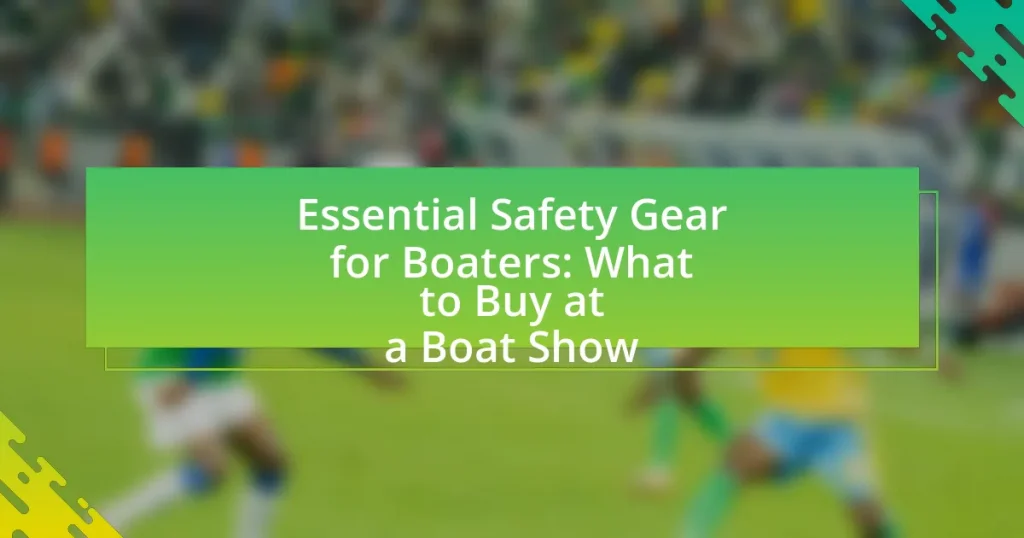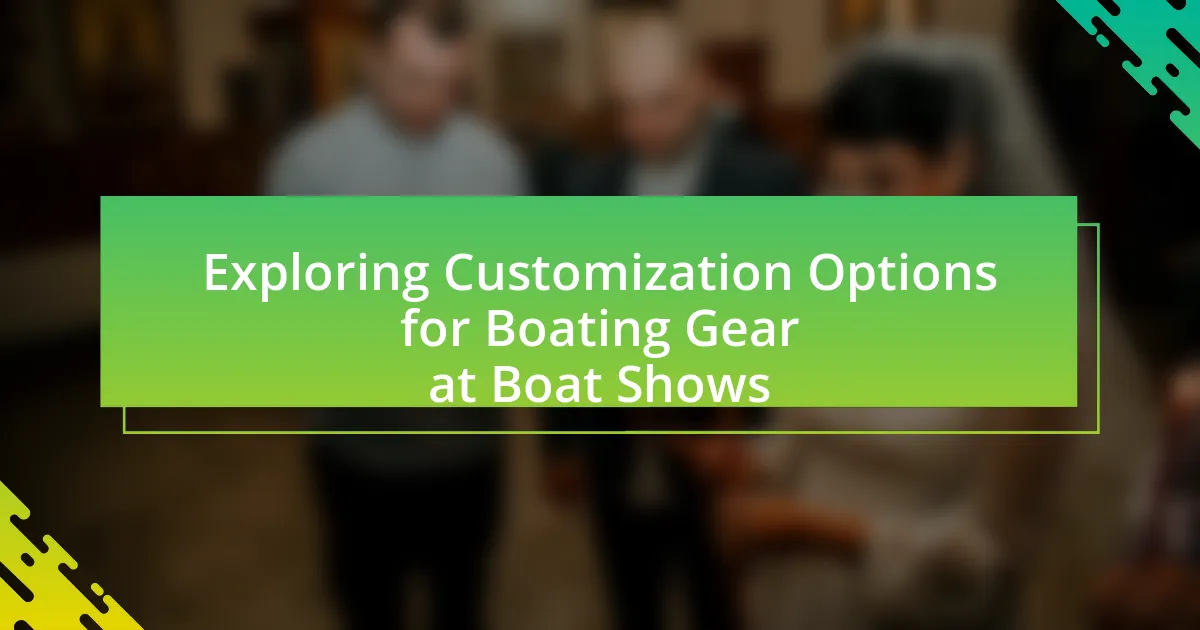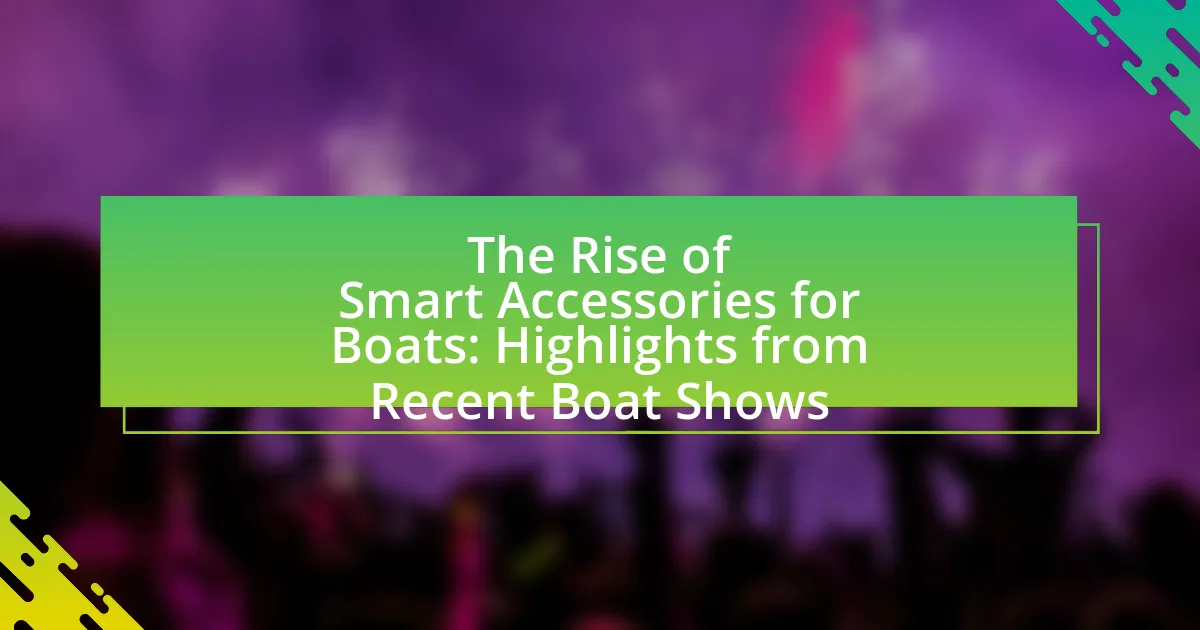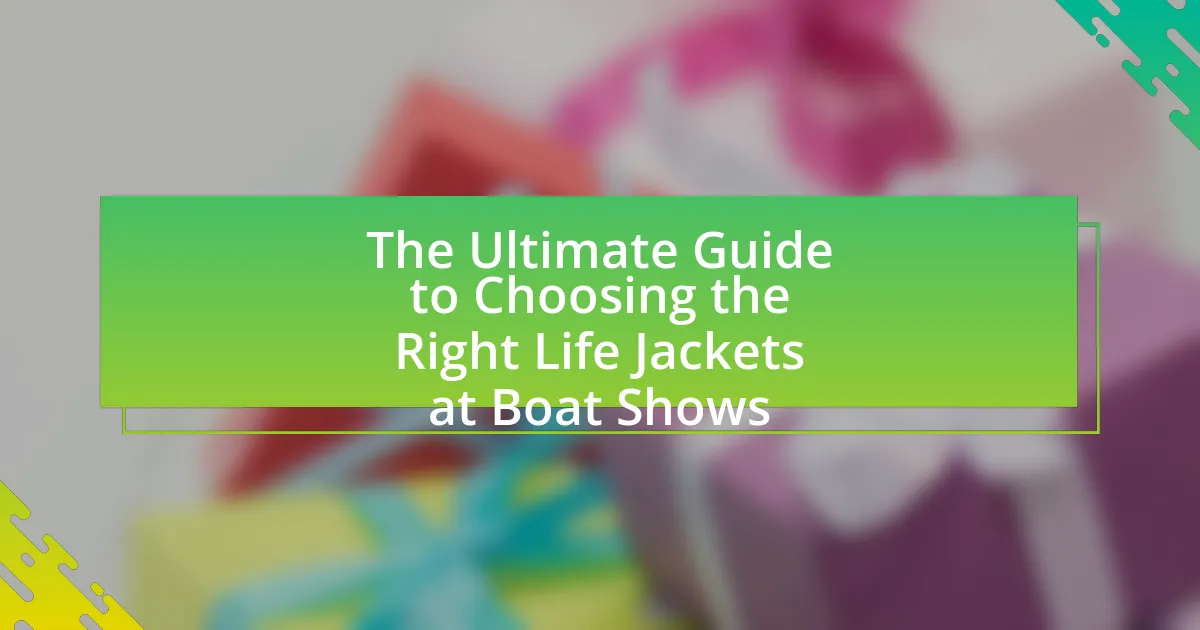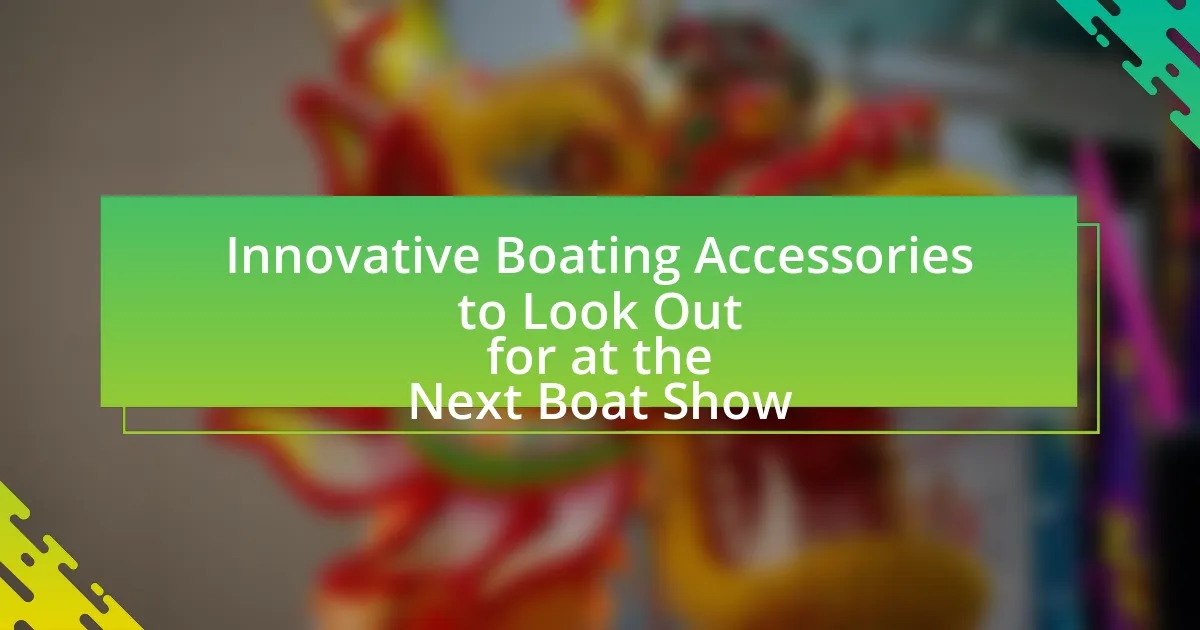Essential safety gear for boaters is crucial for ensuring safety and compliance while on the water. Key items include life jackets, fire extinguishers, signaling devices, and first aid kits, each serving specific purposes to mitigate risks associated with boating. The article emphasizes the importance of having the right safety equipment, the potential dangers of boating without it, and best practices for selecting and maintaining gear. Additionally, it provides guidance on what to look for at boat shows, helping boaters make informed decisions about their safety equipment.
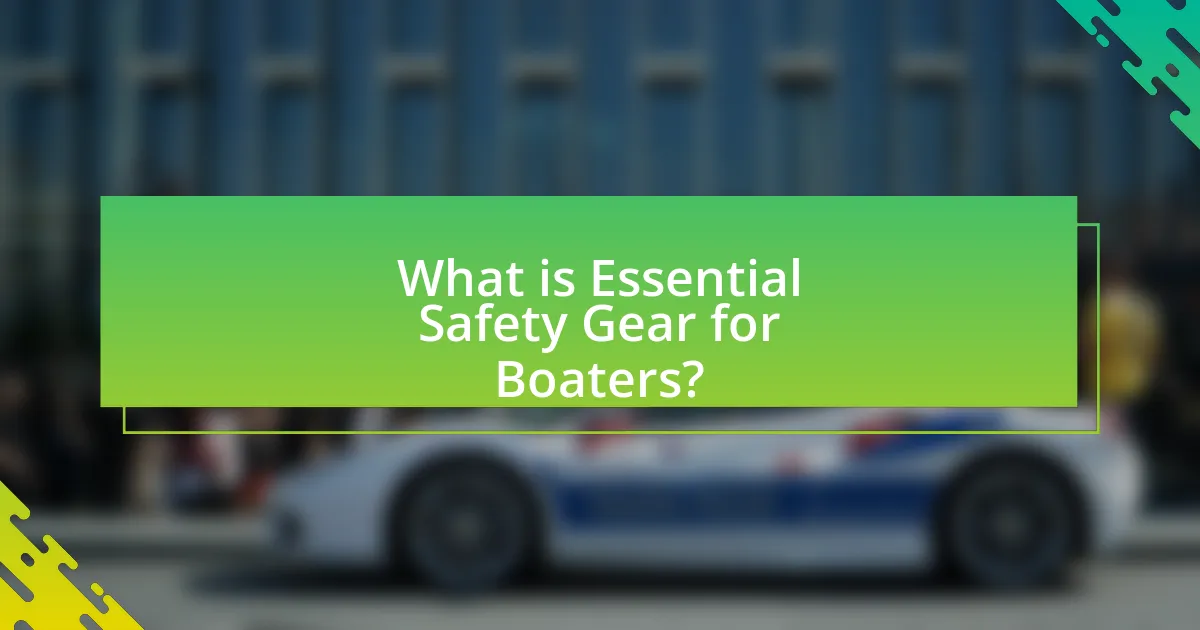
What is Essential Safety Gear for Boaters?
Essential safety gear for boaters includes life jackets, fire extinguishers, signaling devices, and first aid kits. Life jackets are crucial as they provide buoyancy and prevent drowning; regulations often require one for each person on board. Fire extinguishers are necessary for combating onboard fires, with specific types mandated by the U.S. Coast Guard based on boat size. Signaling devices, such as flares or whistles, are vital for alerting others in emergencies. First aid kits are essential for treating injuries that may occur while boating. These items collectively enhance safety and compliance with maritime regulations.
Why is safety gear important for boaters?
Safety gear is important for boaters because it significantly reduces the risk of injury or fatality in emergencies. According to the U.S. Coast Guard, in 2020, 86% of drowning victims were not wearing life jackets, highlighting the critical role of personal flotation devices in preventing deaths. Additionally, safety gear such as fire extinguishers, first aid kits, and signaling devices are essential for responding effectively to accidents or emergencies on the water, ensuring that boaters can protect themselves and others.
What are the potential risks of boating without safety gear?
Boating without safety gear significantly increases the risk of accidents and fatalities. Without essential equipment like life jackets, flares, and fire extinguishers, individuals are more vulnerable to drowning, hypothermia, and injuries during emergencies. According to the U.S. Coast Guard, in 2020, 86% of drowning victims were not wearing life jackets, highlighting the critical importance of this safety gear. Additionally, the absence of safety gear can lead to legal repercussions, as many jurisdictions require specific equipment on board.
How does safety gear enhance boating experiences?
Safety gear enhances boating experiences by significantly reducing the risk of accidents and injuries on the water. When boaters wear life jackets, for instance, they increase their chances of survival in case of capsizing or falling overboard, as statistics show that drowning is a leading cause of boating fatalities. Additionally, safety gear such as flares, first aid kits, and fire extinguishers provide essential support during emergencies, ensuring that boaters are prepared for unexpected situations. The presence of safety equipment fosters a sense of security, allowing individuals to enjoy their time on the water with greater peace of mind.
What types of safety gear should boaters consider?
Boaters should consider personal flotation devices (PFDs), fire extinguishers, first aid kits, signaling devices, and emergency communication equipment as essential safety gear. PFDs are crucial for preventing drowning, as statistics show that 84% of boating fatalities involve individuals not wearing life jackets. Fire extinguishers are necessary for handling onboard fires, while first aid kits provide immediate medical assistance in emergencies. Signaling devices, such as flares or whistles, are vital for attracting attention in distress situations. Emergency communication equipment, like VHF radios, ensures boaters can call for help when needed.
What are the essential items every boater should have?
Every boater should have a life jacket, a fire extinguisher, a first aid kit, a whistle, and a navigation system. Life jackets are crucial for safety, as they are required by law in many jurisdictions and can save lives in emergencies. A fire extinguisher is essential for preventing and controlling onboard fires, which can occur due to fuel leaks or electrical malfunctions. A first aid kit is necessary for treating injuries that may occur while boating, ensuring that minor accidents can be managed effectively. A whistle serves as a signaling device to attract attention in case of distress, while a navigation system, whether GPS or charts, is vital for safe travel and avoiding hazards on the water. These items collectively enhance safety and preparedness for any boating excursion.
How do different types of safety gear serve specific purposes?
Different types of safety gear serve specific purposes by providing protection against various hazards encountered while boating. For instance, life jackets are designed to keep individuals afloat in water, significantly reducing the risk of drowning; studies show that wearing a life jacket increases survival rates in boating accidents. Similarly, personal flotation devices (PFDs) are essential for ensuring buoyancy and safety during unexpected falls overboard. Additionally, fire extinguishers are crucial for combating onboard fires, with regulations requiring specific types based on the potential fire hazards present on a vessel. Each piece of safety gear is tailored to address particular risks, thereby enhancing overall safety for boaters.
Where can boaters find safety gear at a boat show?
Boaters can find safety gear at a boat show in designated vendor booths that specialize in marine safety equipment. These booths typically feature a range of products, including life jackets, flares, fire extinguishers, and first aid kits. Boat shows often have a specific section or area dedicated to safety gear, making it easier for attendees to locate these essential items. Additionally, many manufacturers and retailers showcase their latest safety innovations at these events, providing boaters with the opportunity to compare products and receive expert advice on safety gear.
What should boaters look for in vendors at a boat show?
Boaters should look for vendors that offer high-quality safety gear, reliable products, and knowledgeable staff at a boat show. High-quality safety gear includes life jackets, flares, and fire extinguishers that meet regulatory standards, ensuring compliance and safety on the water. Reliable products are often backed by warranties and positive customer reviews, indicating their effectiveness and durability. Knowledgeable staff can provide valuable insights and recommendations based on the latest safety regulations and best practices, enhancing the boater’s understanding of essential safety gear.
How can boat shows help in comparing safety gear options?
Boat shows facilitate the comparison of safety gear options by providing a centralized venue where various manufacturers showcase their products side by side. Attendees can physically inspect, try on, and evaluate the features of different safety gear, such as life jackets, flares, and first aid kits, which enhances informed decision-making. Additionally, boat shows often include expert demonstrations and presentations that highlight the effectiveness and specifications of safety gear, allowing consumers to assess performance and compliance with safety standards. This direct interaction with products and experts enables boaters to make well-informed choices tailored to their specific needs.

How to Choose the Right Safety Gear at a Boat Show?
To choose the right safety gear at a boat show, first assess your specific boating activities and conditions. Identify essential items such as life jackets, fire extinguishers, and first aid kits that meet safety regulations and personal needs. For instance, the U.S. Coast Guard mandates that all boats carry a properly fitting life jacket for each person on board, which underscores the importance of selecting gear that complies with safety standards. Additionally, consider the quality and certifications of the gear, such as those from the National Marine Manufacturers Association, to ensure reliability and effectiveness in emergencies.
What factors should boaters consider when selecting safety gear?
Boaters should consider the type of water conditions, the number of passengers, and the specific activities planned when selecting safety gear. Water conditions, such as rough seas or calm lakes, dictate the need for different gear types; for instance, life jackets must be suitable for the environment. The number of passengers affects the quantity and type of safety equipment required, ensuring that everyone has access to personal flotation devices. Additionally, activities like fishing or water sports may necessitate specialized gear, such as harnesses or helmets. These considerations ensure compliance with safety regulations and enhance overall safety on the water.
How does the type of boating activity influence gear selection?
The type of boating activity significantly influences gear selection by determining the specific safety and functional requirements needed for that activity. For instance, recreational boating typically requires basic safety gear such as life jackets, while activities like sailing necessitate additional equipment like harnesses and safety lines due to the increased risk of falling overboard. Furthermore, fishing activities may require specialized gear such as tackle boxes and rod holders, while water sports like wakeboarding demand protective gear like helmets and impact vests. This differentiation in gear is essential for ensuring safety and enhancing the overall experience during various boating activities.
What are the key features to look for in safety gear?
Key features to look for in safety gear include durability, comfort, visibility, and compliance with safety standards. Durability ensures that the gear can withstand harsh marine conditions, while comfort allows for ease of movement during activities. Visibility is crucial for being seen in low-light conditions, often achieved through bright colors or reflective materials. Compliance with safety standards, such as those set by the U.S. Coast Guard, guarantees that the gear meets essential safety requirements, providing an additional layer of protection for boaters.
How can boaters ensure they are purchasing quality safety gear?
Boaters can ensure they are purchasing quality safety gear by verifying that the equipment meets established safety standards, such as those set by the U.S. Coast Guard or the American Boat and Yacht Council. These organizations provide guidelines and certifications that indicate the gear has been tested for reliability and effectiveness. Additionally, boaters should check for product reviews and ratings from reputable sources, as well as seek recommendations from experienced boaters or professionals in the industry. This approach helps confirm the safety gear’s performance and durability, ensuring it will function properly in emergency situations.
What certifications should safety gear have?
Safety gear should have certifications such as the U.S. Coast Guard (USCG) approval, American National Standards Institute (ANSI) standards, and Underwriters Laboratories (UL) certification. These certifications ensure that the safety gear meets specific safety and performance standards, providing reliable protection for users. For instance, USCG approval indicates compliance with federal safety regulations for boating equipment, while ANSI standards ensure that personal protective equipment meets rigorous testing criteria. UL certification further verifies that the gear has undergone safety testing and meets industry standards for electrical and fire safety.
How can boaters assess the durability of safety gear?
Boaters can assess the durability of safety gear by examining materials, construction quality, and manufacturer certifications. High-quality safety gear typically uses robust materials like nylon or polyester, which are resistant to wear and tear. Additionally, inspecting stitching and seams for reinforcement can indicate better durability. Certifications from recognized organizations, such as the U.S. Coast Guard or ISO standards, provide assurance that the gear meets specific safety and durability benchmarks. For example, life jackets that are U.S. Coast Guard-approved have undergone rigorous testing for performance and durability in marine environments.
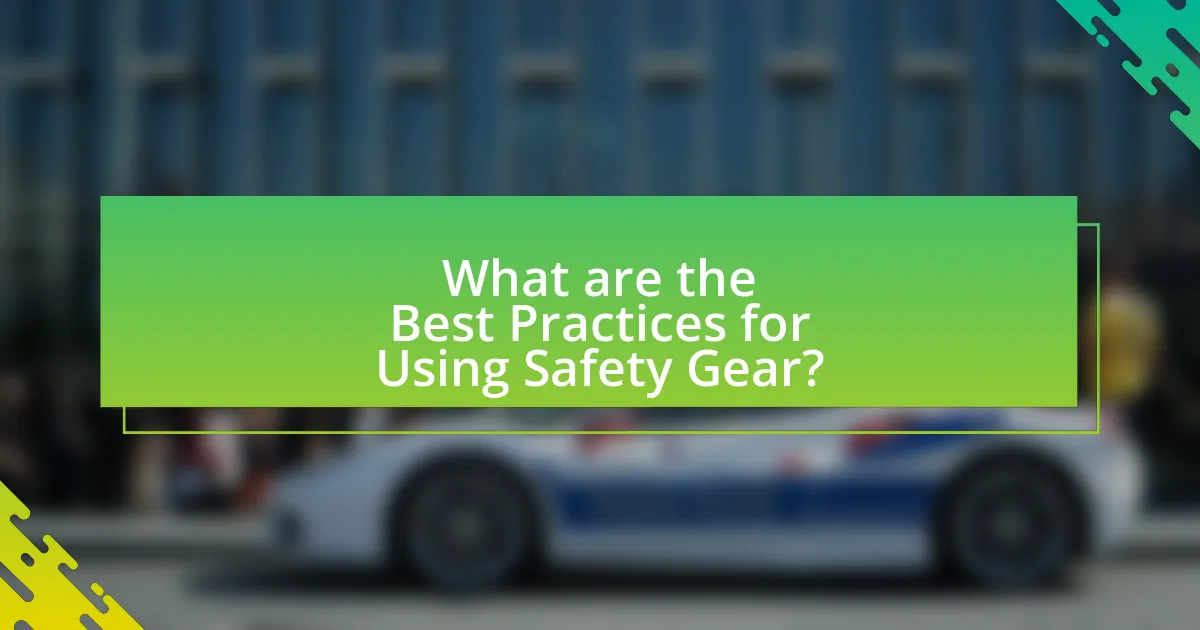
What are the Best Practices for Using Safety Gear?
The best practices for using safety gear include ensuring proper fit, regular inspection, and appropriate usage based on the activity. Proper fit is crucial, as ill-fitting gear can compromise safety; for example, life jackets should be snug but not restrictive. Regular inspection of safety gear, such as checking for wear and tear on life jackets and fire extinguishers, ensures functionality when needed. Additionally, using safety gear according to specific boating activities—like wearing a personal flotation device while on deck or during rough weather—enhances safety. According to the U.S. Coast Guard, wearing a life jacket can reduce drowning risk by 85%, highlighting the importance of proper usage.
How should boaters maintain their safety gear?
Boaters should maintain their safety gear by regularly inspecting, cleaning, and replacing items as necessary. Regular inspections should include checking life jackets for tears or wear, ensuring fire extinguishers are charged and accessible, and verifying that flares and signaling devices are not expired. Cleaning safety gear, such as life vests and first aid kits, helps prevent deterioration and ensures functionality. Additionally, boaters should replace any damaged or outdated equipment promptly to comply with safety regulations and ensure readiness in emergencies. Regular maintenance not only enhances safety but also prolongs the lifespan of the gear.
What are the common maintenance tips for life jackets?
Common maintenance tips for life jackets include regular inspection for damage, cleaning with mild soap and water, and proper storage. Inspecting life jackets for tears, frayed straps, or damaged buckles ensures they remain functional and safe. Cleaning them prevents mold and mildew, which can compromise their integrity. Storing life jackets in a cool, dry place away from direct sunlight helps maintain their materials and buoyancy. Regularly checking the expiration date, if applicable, is also crucial, as some life jackets have a limited lifespan.
How often should safety gear be inspected for wear and tear?
Safety gear should be inspected for wear and tear at least once a year. Regular inspections are crucial to ensure that equipment such as life jackets, fire extinguishers, and flares remain functional and safe for use. According to the U.S. Coast Guard, annual checks help identify any damage or deterioration that could compromise safety during boating activities.
What are the common mistakes boaters make with safety gear?
Common mistakes boaters make with safety gear include failing to regularly inspect and maintain equipment, not having enough life jackets for all passengers, and neglecting to familiarize themselves with the gear’s proper use. Regular inspections are crucial, as statistics show that poorly maintained safety gear can lead to accidents. Additionally, the U.S. Coast Guard mandates that all vessels carry a life jacket for each person on board, yet many boaters overlook this requirement, risking safety during emergencies. Lastly, not understanding how to operate safety equipment, such as fire extinguishers or flares, can hinder effective responses in critical situations.
Why is it important to familiarize oneself with safety gear before use?
Familiarizing oneself with safety gear before use is crucial for ensuring effective protection and proper functionality during boating activities. Understanding how to correctly wear and operate safety equipment, such as life jackets and fire extinguishers, can significantly reduce the risk of accidents and injuries. For instance, the U.S. Coast Guard reports that drowning is the leading cause of death in boating accidents, often due to improper use of life jackets. Therefore, knowing how to properly fit and utilize safety gear can enhance a boater’s preparedness and response in emergencies, ultimately saving lives.
How can improper use of safety gear lead to accidents?
Improper use of safety gear can lead to accidents by failing to provide the necessary protection during boating activities. For instance, wearing a life jacket that is not properly fitted can result in it slipping off during an emergency, increasing the risk of drowning. According to the U.S. Coast Guard, 86% of drowning victims were not wearing a life jacket, highlighting the critical importance of correct usage. Additionally, using outdated or damaged safety equipment, such as flares or fire extinguishers, can lead to ineffective responses in emergencies, further exacerbating the risk of accidents on the water.
What are some practical tips for maximizing safety on the water?
To maximize safety on the water, always wear a life jacket that is appropriate for your activity and size. Life jackets significantly reduce the risk of drowning; the U.S. Coast Guard reports that 86% of drowning victims were not wearing a life jacket. Additionally, ensure that your vessel is equipped with essential safety gear, such as flares, a first aid kit, and a fire extinguisher, as these items can be critical in emergencies. Regularly check weather conditions before heading out, as sudden changes can pose serious risks. Lastly, maintain a proper lookout and avoid distractions while operating the vessel to prevent accidents.
